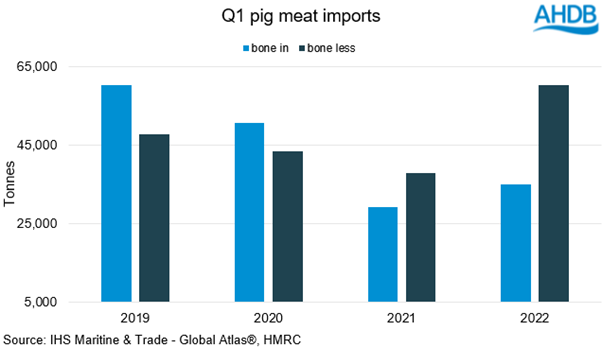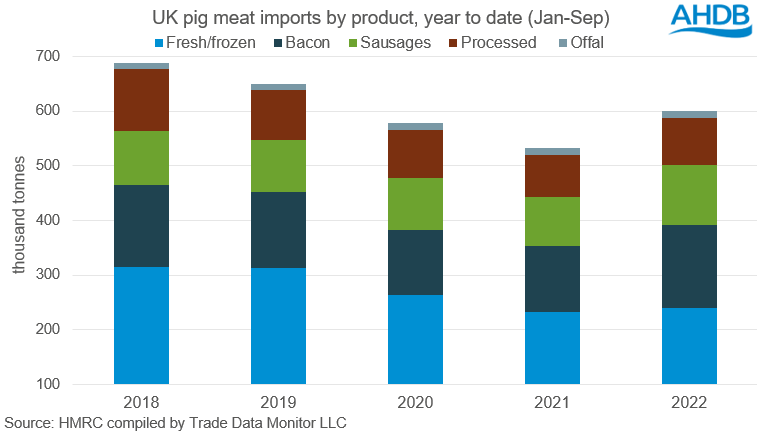What’s behind the increase in UK pork imports?
Thursday, 1 December 2022
September’s trade figures show that so far this year (Jan-Sep) the UK has imported 587,300 tonnes of pig meat (excluding offal). Although this is a 13% increase in volume compared to this time last year, comparisons to 2021 and 2020 are not fairly comparable due to the impacts of adjusting to new Brexit trading and covid-19 restrictions. If we compare current imports to those from 2019, volumes are lower in 2022 by 50,500 tonnes (-8%).

Data from earlier this year shows that the UK appeared to be making use of butchery abroad to produce the specific cuts in demand as staff shortages limited domestic butchery capacity. Prior to the pandemic and Brexit, bone-in products were imported in larger volumes than boneless, however in late 2021 and early 2022 this switched.

Despite our summer outlook forecasting that total UK demand for pork would fall 2% (across 2022) due to the cost of living crisis, food service volumes are up 23% year on year (52 weeks ending 4 Sep). Covid restrictions limited opportunities for this market in 2021 which is less likely to source British. This matters in the context of increased imports, as this could be the main destination for imported product, considering the share of British product has increased in the retail sector.
Breakfast is the meal in foodservice which has seen the biggest growth in pork volumes compared to last year. An additional 14.8m kg of pork was sold in breakfasts in the last year, most of which will be bacon or sausages. This supports the growth seen in imports, as the bacon and sausage categories have seen the largest growth year on year, up 26% and 23% respectively.
Looking ahead, it is likely imported volumes of pork to the UK will continue to grow if demand is sustained alongside declining production. In the June Defra survey, the English pig breeding herd fell 18% year on year. This paired with the ongoing cost pressures faced by producers means it is unlikely we will see a quick recovery in pig numbers, limiting the number of animals that will be available for slaughter.

Sign up for regular updates
Subscribe to receive pork market news straight to your inbox. Simply complete our online form.
While AHDB seeks to ensure that the information contained on this webpage is accurate at the time of publication, no warranty is given in respect of the information and data provided. You are responsible for how you use the information. To the maximum extent permitted by law, AHDB accepts no liability for loss, damage or injury howsoever caused or suffered (including that caused by negligence) directly or indirectly in relation to the information or data provided in this publication.
All intellectual property rights in the information and data on this webpage belong to or are licensed by AHDB. You are authorised to use such information for your internal business purposes only and you must not provide this information to any other third parties, including further publication of the information, or for commercial gain in any way whatsoever without the prior written permission of AHDB for each third party disclosure, publication or commercial arrangement. For more information, please see our Terms of Use and Privacy Notice or contact the Director of Corporate Affairs at info@ahdb.org.uk © Agriculture and Horticulture Development Board. All rights reserved.


